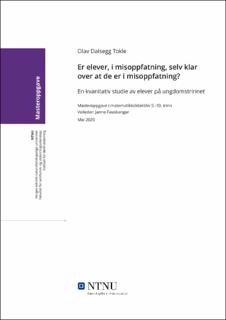| dc.contributor.advisor | Fauskanger, Janne | |
| dc.contributor.author | Tokle, Olav Dalsegg | |
| dc.date.accessioned | 2021-09-28T17:44:18Z | |
| dc.date.available | 2021-09-28T17:44:18Z | |
| dc.date.issued | 2020 | |
| dc.identifier | no.ntnu:inspera:55577898:38305534 | |
| dc.identifier.uri | https://hdl.handle.net/11250/2784829 | |
| dc.description.abstract | Studien fokuserer på seks misoppfatninger knyttet til algebra gjennom å belyse to forskningsspørsmål:
1. Er elever, som er i misoppfatning, selv klar over at de er i en misoppfatning?
2. Hvor utberedt er misoppfatninger knyttet til algebra?
Elever i misoppfatninger er i denne studien definert som elever som avgir svar som tyder på misoppfatning i alle oppgavene som tester samme misoppfatning.
Studien er gjennomført på et utvalg av 368 elever på 8.–10. trinn. Metoden som er valgt er en diagnostisk test som består av flerlagsoppgaver der elevenes matematiske svar blir undersøkt gjennom to spørsmål per oppgave. I tillegg inneholder hver oppgave et spørsmål om hvor sikre elevene er på at det matematiske svaret de avgir er riktig. En litteraturgjennomgang tyder på at denne metoden ikke er mye benyttet i tidligere forskning om misoppfatninger. Erfaringene fra denne studien tyder imidlertid på at metoden er vellykket, og at den gir et godt innblikk i elevenes tenkning og eventuelle misoppfatninger.
Forskningsspørsmålene er forsøkt besvart gjennom en kvantitativ analytisk tilnærming, der hypoteser er testet gjennom variasjonsanalyse og khikvadrattester. Et eksempel på en slik hypotese; det er ingen statistisk signifikant forskjell mellom hvordan elever i misoppfatning uttrykker grad av sikkerhet til eget svar, sammenlignet med elever som ikke er i misoppfatning.
Resultatene fra studien viser at elever i misoppfatning uttrykker høy grad av sikkerhet til eget svar. For fire av seks misoppfatninger studien undersøker, uttrykker elever i misoppfatning i gjennomsnitt lik eller høyere grad av sikkerhet, sammenlignet med elever som ikke er i misoppfatning. For to av disse misoppfatningene er forskjellene statistisk signifikante. Resultatene viser også at misoppfatninger er vanlige blant utvalget som deltok i studien, ved at over 40 % av elevene er i én eller flere misoppfatninger. Funnene i studien viser også at noen av misoppfatningene har høyere utbredelse på 10. trinn enn på 8. trinn. | |
| dc.description.abstract | This study focusses on six misconceptions related to algebra through two research questions:
1. Are students in misconceptions*, aware that they are in misconceptions?
2. How common are misconceptions related to algebra?
In this study, students in misconceptions are defined as students who provide answers that indicate misconception in all the items that test the same misconception.
The study was conducted on 368 students from grade 8 through grade 10. The method for data collection is a multi-tier diagnostic test, where the students' mathematical answers are examined through two open ended questions per item. In addition, each item contains a certainty of response index (CRI), through the question how confident are you that the given answer is correct? A literature review indicates that this method has not been widely used in previous research on misconceptions. However, the experience from this study indicates that the method is successful and that it provides a good insight into the students' mathematical thinking and misconceptions.
The research questions have been approached trough a quantitative analytical method, where hypotheses have been tested through variance analysis and chi-square tests. An example of such a hypothesis is; there is no statistically significant difference between the CRI of students in misconception, and the CRI of students who are not in misconception.
The results of the study show that students in misconceptions express a high CRI. For four out of six misconceptions the study examines, students in misconceptions express, on average, equal or higher CRI compared to students who are not in misconception. For two of these misconceptions, the differences are statistically significant. The results also show that misconceptions are common among the students, with at least 40% of students found to be in at least one misconception. The findings of the study also show that some of the misconceptions are more common in grade 10 than in grade 8.
* The phrase ‘being in a misconception’ has recently taken hold in the Norwegian context, in favour of ‘having a misconception' | |
| dc.language | | |
| dc.publisher | NTNU | |
| dc.title | Er elever, i misoppfatning, selv klar over at de er i misoppfatning? | |
| dc.type | Master thesis | |
